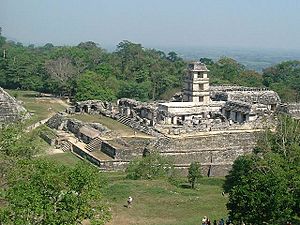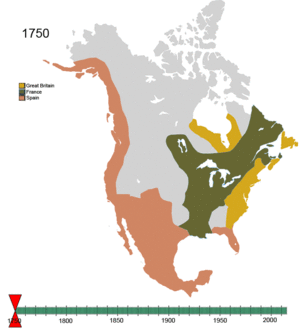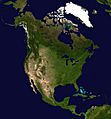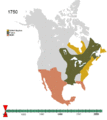History of North America facts for kids
The History of North America tells the story of how people came to live on this continent. Humans arrived here much later than in places like Africa, Europe, and Asia.
Scientists have different ideas about where the first people in North America came from. However, the Native peoples of North America have their own stories that say they have been on this land since the very beginning.
Contents
Before Europeans Arrived
Before Europeans came, the native people of North America lived in many different groups. Some were small families, while others were large empires. They lived in various cultural areas, which were often linked to the land and its animals. For example, there were Bison hunters on the Great Plains and farmers in Mesoamerica. Native groups can also be sorted by their language family. It's important to remember that groups with similar languages didn't always share the same way of life or even get along.
Scientists believe the Inuit people of the far Arctic arrived in North America much later than other native groups. This is shown by old tools and items found by archaeologists.
Over thousands of years, native cultures changed and grew. Archaeologists often name ancient cultures after the place where their remains are first found. One of the oldest known cultures is the Clovis culture in what is now New Mexico. A more recent example is the group of cultures called the Mound builders, found in the Mississippi River valley. They thrived from about 3000 BC to the 1500s AD.

The native groups in the southern parts of North America were the first to grow many common crops we use today, like tomatoes and squash. Most importantly, they domesticated maize (corn), which became a major food source around the world.
Because farming developed in the south, amazing cultural advancements were possible there. For instance, the Maya civilization created a writing system, built huge pyramids, had a complex calendar, and even developed the idea of zero 500 years before anyone in the Old World (Europe, Asia, Africa). The Maya culture was still present when the Spanish arrived in Central America. However, by then, the powerful Aztec Empire had taken control of the area further north.
When Europeans arrived in the "New World," the lives of native peoples changed greatly. Their connections to political and cultural groups shifted. Some language groups disappeared, and others changed very quickly. The names and cultures that Europeans wrote down for the natives were not always the same as those used just a few generations before, or even today.
Europeans Arrive
Early Discoveries
There was very little contact between North American peoples and the outside world before 1492. Some theories suggest earlier visits, but the first clear evidence comes from the Norse, also known as Vikings. The Norse captain Leif Erikson is thought to have reached the Island of Newfoundland around 1000 AD. They called their new discovery Vinland. The only Norse site found in North America so far is at L'Anse-aux-Meadows in Newfoundland and Labrador. The Norse settlements were later abandoned.
The Viking voyages were not widely known in Europe, so most Europeans didn't know about the Americas until 1492. As part of a general age of discovery, an Italian sailor named Christopher Columbus suggested sailing west from Europe to find a shorter way to Asia. He eventually got support from Queen Isabella I and King Ferdinand II of newly united Spain. In 1492, Columbus landed in the Bahamas.
Almost 500 years after the Norse, John Cabot explored the east coast of what would become Canada in 1497. Giovanni da Verrazzano explored the East Coast of America from Florida to Newfoundland in 1524. Jacques Cartier made several trips for the French king in 1534 and sailed up the St. Lawrence River.
Successful Colonization
At first, Europeans mainly focused on trade and exploration. But eventually, they began to build settlements. The three main colonial powers were Spain, England, and France. Even smaller powers like the Netherlands and Sweden gained small areas on the continent.
Spanish settlement started the European colonization of the Americas. This involved terrible violence against the native peoples. Spain took control of most of the large islands in the Caribbean and conquered the Aztecs, gaining control of what is now Mexico and Central America. This was the start of the Spanish Empire in the New World. The first successful Spanish settlement on the North American mainland was Veracruz in 1519. Many other settlements followed in colonial New Spain and Spanish Florida.
The first successful English settlements were at Jamestown (1607) and Plymouth (1620), in what are now Virginia and Massachusetts. The first French settlements were Port Royal (1604) and Quebec City (1608) in what are now Nova Scotia and Quebec. The fur trade soon became the main business on the continent, which greatly changed the lives of Native Americans.
Further south, large farms called plantations became the main industry in the West Indies. This led to the start of the Atlantic slave trade, where people were forcibly taken from Africa and brought to the Americas to work.
Colonial Era
By 1663, the French king had taken control of New France from the fur-trading companies. Similarly, the English charter colonies came under more direct control from England. This began a new period of more organized colonialism in North America.
Competition between the European powers led to a series of wars on the North American continent. These wars had a huge impact on how the colonies developed. Land often changed hands many times. Peace was finally achieved when French forces in North America were defeated at the Battle of the Plains of Abraham in Quebec City. France then gave up most of its claims in North America, except for some islands in the Caribbean.
The Viceroyalty of New Spain was the name for the territories ruled by a viceroy (a governor representing the king) for the Spanish Empire. It covered parts of Asia, North America, and nearby areas from 1535 to 1821.
Age of Revolutions
The start of the American Revolution had a big impact across the continent. Most importantly, it directly led to the creation of the United States of America. The American Revolutionary War was a major conflict that affected the entire region. Many people who supported the British, called United Empire Loyalists, moved north, which helped create English Canada as a separate community.
Meanwhile, Spain's control over Mexico was weakening. Independence was declared in 1810 by Miguel Hidalgo, starting the Mexican War of Independence. In 1813, José María Morelos and the Congress of Anáhuac signed the Solemn Act of the Declaration of Independence of Northern America. This was the first official document declaring Mexico's separation from Spain. Spain finally recognized Mexico's independence in 1821.
Expansion Era
After the United States gained independence, the country quickly expanded west. It bought the huge Louisiana territory in 1803. An attempt to expand north was stopped by Britain during the War of 1812. At the same time, more British people settled in Canada.
US expansion was complicated by the division between "free" states (where slavery was not allowed) and "slave" states (where it was). This led to agreements like the Missouri Compromise in 1820. Similarly, Canada faced a division between its French and English communities, which led to civil unrest in 1837. Mexico faced constant political struggles between different groups. The English-speaking region of Tejas rebelled and declared itself the Republic of Texas in 1836. In 1845, Texas joined the United States, which later led to the Mexican–American War. As a result of this war, the United States gained more land in California and the Southwest.
In Mexico, this entire period was largely controlled by the dictatorship of Porfirio Díaz.
World Wars Era
The Great War (World War I)
As part of the British Empire, Canada immediately joined the war in 1914. Canadian troops fought bravely in several major battles early in the war, including facing poison gas attacks at Ypres. Troops from Newfoundland suffered a terrible loss on July 1, 1916, during the First day on the Somme. As losses grew, the Canadian government eventually brought in conscription (forcing people to join the military), even though most French Canadians were against it. This led to the Conscription Crisis of 1917, with riots breaking out in Montreal.
The United States stayed out of the conflict until 1917, when it joined the Allied powers. The United States then played a key role at the Paris Peace Conference of 1919, which helped shape Europe in the years between the wars.
Mexico did not take part in World War I because the country was busy with its own Mexican Revolution at the time.
Interwar Years
The 1920s brought a time of great wealth in the United States, and to a lesser extent, Canada. But the Wall Street Crash of 1929 (a stock market crash) combined with a severe drought led to a period of economic hardship in both the United States and Canada. This period is known as the Great Depression.
From 1936 to 1949, there was a popular uprising in Mexico against the anti-Catholic government of the time. This was sparked by rules in the Mexican Constitution of 1917 that limited the power of the church.
The Second World War
Once again, Canada found itself at war before its neighbors. However, even Canada's contributions were small before the Japanese attack on Pearl Harbor in 1941.
The entry of the United States into the war helped to turn the tide in favor of the Allies.
Two Mexican oil tankers, carrying oil to the United States, were attacked and sunk by German forces in the Gulf of Mexico in 1942. This happened even though Mexico was neutral at the time. This incident led Mexico to declare war on the Axis nations and join the conflict.
The widespread destruction in Europe during the war meant that North American countries took on more important roles in world affairs. The United States especially emerged as a "superpower".
Post-War
The early Cold War era saw the United States as the most powerful nation in a Western alliance that also included Mexico and Canada. At home, the United States saw huge changes, especially in race relations. In Canada, this was reflected by the Quiet Revolution and the rise of Quebec nationalism.
Mexico experienced a time of huge economic growth after World War II. It went through a major industrialization process, and its middle class grew. This period is known in Mexican history as the "El Milagro Mexicano" (Mexican miracle).
In the Caribbean, countries began to gain their independence from colonial powers. On the largest island, the Cuban Revolution brought Cold War rivalries into Latin America.
Images for kids
-
A composed satellite photograph of North America in orthographic projection.
-
Folsom projectile point, an ancient tool.
-
1844 Map of North America, after the Mexican American War.
See also
 In Spanish: Historia de América del Norte para niños
In Spanish: Historia de América del Norte para niños








